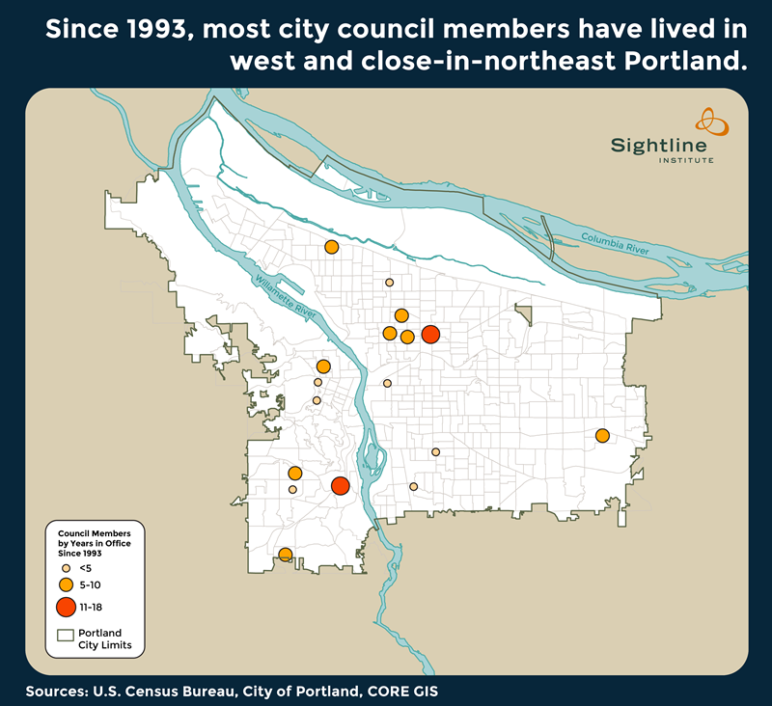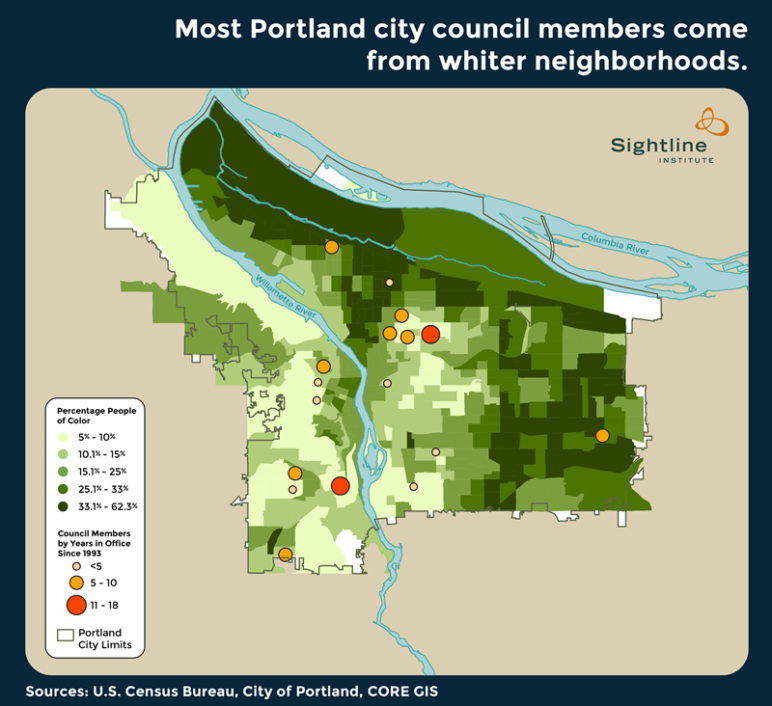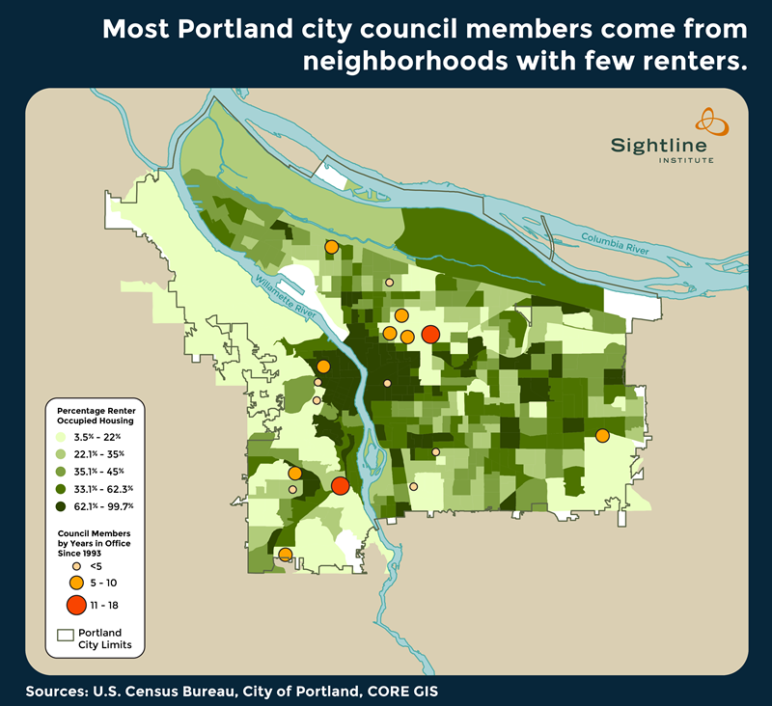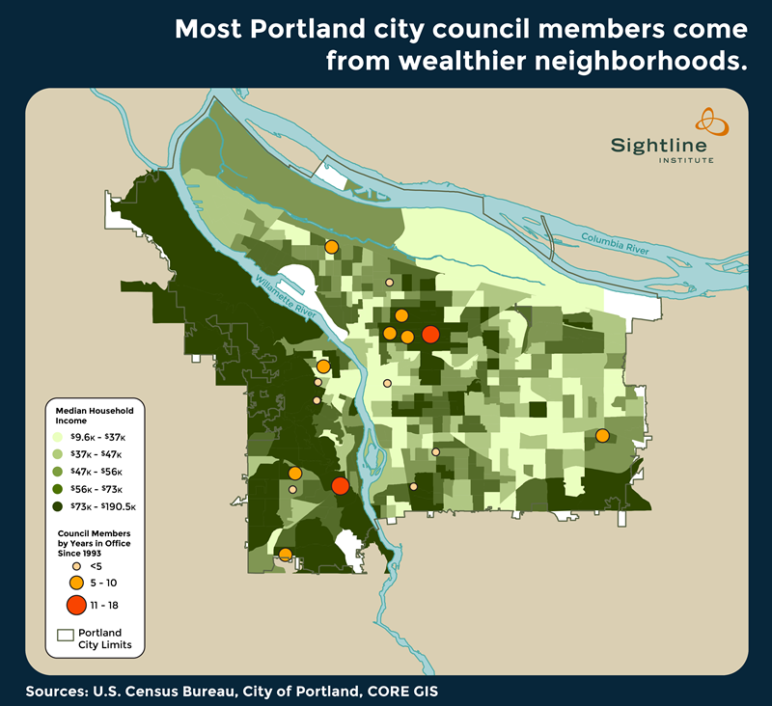UPDATE June 15: The article has been updated to explain how the analysis tracks the addresses of the two council members—Charlie Hales and Nick Fish—who lived at two different addresses while in office, and to reflect the fact that Nick Fish is now a renter, after 20 years of being a homeowner in Grant Park.
Portland has a problem. By electing its councilors to at-large numbered seats, the Rose City ensures that its councilors look largely the same: white, male homeowners from the West and central parts of the city. In a city that is nearly one-third people of color, only two people of color (Charles Jordan and Dick Bogle) have ever served on the council. In a city that is one-half women, only eight women have ever served on city council (Dorothy McCullough Lee, Connie McCready, Mildred Schwab, Margaret Strachan, Gretchen Kafoury, Vera Katz, Amanda Fritz, and Chloe Eudaly), compared with more than 50 men. No woman of color has ever served on the council. In a city where more than one-third of residents rent and where rising rents are an increasingly urgent issue, the first lifelong renter—possibly ever—just joined the council in 2017.
Portland has elected councilors from at-large numbered seats for more than 100 years, but in the 21st century, the city could make a change. Other ways of electing the council can ensure that women, people of color, the East side, renters, and lower-income Portlanders get better representation. This article lays out how the city council doesn’t represent the geographical, racial, ethnic, or economic diversity of Portland. The next article will outline the choices in designing city government that could make the council more representative. A third article will document other ways of electing the Portland city council.
Southwest and Central Northeast are over-represented
Portland councilors and mayors come disproportionately from the Southwest and central Northeast parts of the city. Few representatives come from North, Southeast, and East Portland. The Oregonian mapped councilors’ addresses since 1913 and found that more than half came from a seven-square-mile box in the close-in east side. But for most of the 20th century East Portland wasn’t a part of the Rose City, so it isn’t surprising there were no East Portland councilors.
If we add up all the years each councilor served since 1993—when Portland had roughly the same boundaries it does now—through now, more than two-thirds of the years served on council were by people living in the more affluent Southwest (Charlie Hales until 2007, Dan Saltzman, Amanda Fritz, Steve Novick, Ted Wheeler, Nick Fish since 2016) and central Northeast (Gretchen Kafoury, Jim Francesconi, Erik Sten, Nick Fish) neighborhoods. Sam Adams was the only representative from North Portland. Randy Leonard was the only one from east of 82nd.
The map below shows the addresses of all city councilors from 1993 through 2016, with bigger, darker circles meaning more years on council and smaller lighter circles meaning fewer years on council. Two council members—Charlie Hales and Nick Fish—lived at two different addresses while serving in office, so they each have two dots representing their years in office while living at each address and the analysis below uses their years of service at each address. If the city were divided into four equal-population districts—West, Northeast, East, and Southeast, almost all council-years served would have come from just two districts (West and Northeast).

White men are over-represented
Fifty-two people have served on Portland city council from 1913 to today: 42 white men, 8 white women, and 2 men of color. There has never been a woman of color on Portland city council. In the past quarter-century, not a single person of color has served. Since 1995, eleven white men have collectively served 78 percent of the years, while four white women have collectively served 22 percent of years in office. The council has not adequately represented a city that is half women and nearly one-third people of color.
Let’s compare that with a city of similar demographics. During the same period (1995 to today) in Cambridge, Massachusetts, with over one-third people of color, 17 white men (including a Muslim man whose parents were immigrants) collectively served just 57 percent of years on city council, while 8 white women served 26 percent of years, two men of color served 10 percent of years, and one woman of color has served 7 percent of years on city council. Like Portland, Cambridge elects its councilors from the city as a whole rather than from districts. But in Cambridge, all candidates run in a single pool, and voters get to rank their choices. Whereas Portland’s at-large system lets the white majority elect every single councilor, Cambridge’s fair voting system empowers people of color and women to consistently win seats on the council. Cambridge also uses multi-winner ranked-choice voting to elect its school board, which is even more diverse than the city council.

In Portland, not only are city councilors themselves all white, but they also tend to live in whiter neighborhoods. In the map below, the darkest green shows the neighborhoods with the most people of color. The gray circles show the home addresses of city councilors, with the bigger circles indicating more years on the council. Only three councilors—Earl Blumenauer in Buckman, Sam Adams in North Portland, and Randy Leonard in East Portland—came from neighborhoods with more than 20 percent people of color.

Homeowners are over-represented
Portland councilors tend to live in neighborhoods with more homeowners than other parts of the city. In the map below, the darkest green shows the neighborhoods with the most renters. The gray circles show the home addresses of city councilors. Although nearly half of Portlanders rent, only four councilors—Earl Blumenauer, Vera Katz, Sam Adams, and Tom Potter—lived in neighborhoods where more than half of households are renters. (For the past year, Nick Fish has lived in a renter-heavy neighborhood, but for the 20 years before that he lived in the Grant Park neighborhood where 90 percent of residents own their homes.)
Councilor Chloe Eudaly may be the first renter who has never owned a home to ever serve on the Portland city council. It seems likely that her status and experience as a renter, and her campaign focus on housing issues, helped sweep her to office.

Wealthy Portlanders are over-represented
Portland councilors tend to live in neighborhoods with higher incomes than other parts of the city. In the map below, the lightest green shows the neighborhoods with the lowest incomes.
The gray circles show the home addresses of city councilors. Although median household income in Portland is under $50,000, only three councilors—Sam Adams, Tom Potter, and Randy Leonard—lived in neighborhoods with median household incomes under $50,000. The darkest green shows the neighborhoods with the highest incomes. Five councilors—Gretchen Kafoury, Amanda Fritz, Nick Fish (while in Grant park), Charlie Hales (while in Eastmoreland) and Ted Wheeler—lived in neighborhoods with median household incomes above $120,000.

Conclusion
Portland’s five-member city council doesn’t reflect the geographic, racial, gender, or economic diversity of the city’s residents. Councilors disproportionately come from white, wealthy, home-owning neighborhoods and are themselves disproportionately white men. This century, Portland could do better. Open and Accountable Elections Portland, supported by a diverse coalition of Portlanders, will make it easier for a more diverse group of people to run for city council in the future. However, it’s not the only reform needed. The next article will describe choices in changing how city government is structured, and the final article will show how Portland could tweak its election methods to improve representation.
Thanks to CORE GIS for creating the maps in this article.
[list_signup_button button_text=”Like what you|apos;re reading? Get monthly democracy reform updates straight to your inbox.” selected_lists='{“Reclaiming Our Democracy”:”Reclaiming Our Democracy”}’ align=”center”]


Comments are closed.